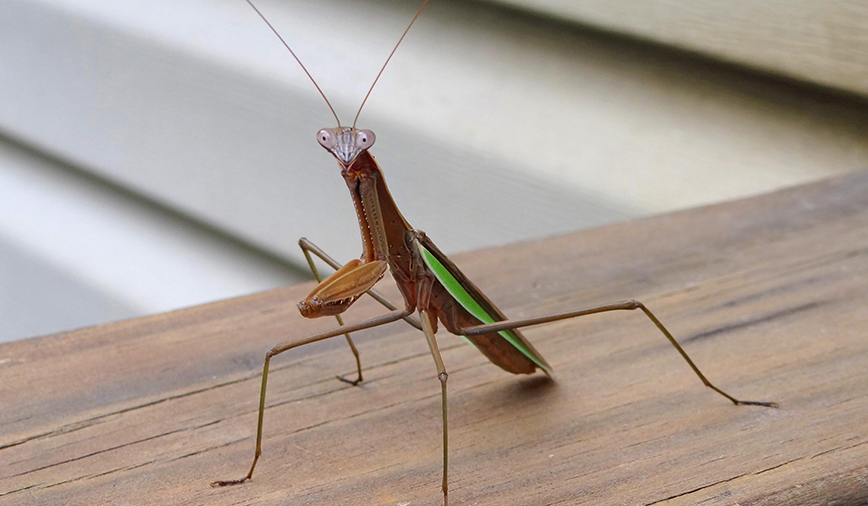We had a blessed event occur in the Nature Room at Pottawatomie Community Center the other day. Make that many blessed events, pretty much all at once. And we didn’t even know we were expecting!
A few months ago, some kind folks brought us an egg case they’d found. Firmly attached to a dried wildlflower stem, the case (also known as an ootheca) looked a lot like a blob of Great Stuff—that aerosol foam sealant you can buy at the hardware store—and a little like a roasted marshmallow. The stem soon joined our own collection of “great stuff” (rocks, shells, feathers, skulls, etc.) and quickly faded from memory.
Until last week. That’s when Lauren, the ever-alert member of our naturalist staff, happened to notice that our “great stuff” appeared to be moving. So did our stack of papers, as well as a container of pens. We soon realized what had happened: The egg case had opened, and we had baby insects everywhere!
The new arrivals were Chinese mantids, a.k.a. praying mantises. Imported for biological pest control, this particular species has been in this country for about 100 years. It’s found throughout the northeastern United States and in recent years has become increasingly prevalent here in northern Illinois.
And now we had about 200 of them, right there in the Nature Room. What to do, what to do?
Well first, of course, we had to do a little observation. Have you ever looked—I mean really looked—at a praying mantis? Its triangular head is dominated by two large compound eyes, clues to the insect’s superb sight-hunting abilities.
Next we noticed the little guys’ astonishingly mobile heads. Mantids are one of a very few insects that possess a functional neck; they can and will move their heads to look you in the eye. The resulting effect is a creature that appears both wise and mysterious, with a dash of extraterrestrial thrown in for good measure.
Even fresh from the egg case, the insects looked like classic mantids, with front legs raised up and claws clasped. It’s no wonder they were named mantis. Mantis in Greek means “prophet or seer” and, if you can set aside the fact that they’re small green insects, they do indeed look like a prophet in prayer. Or, as it turns out a, a predator waiting for prey.
According to a Chinese mantid fact sheet we had on hand, these insects are voracious predators. An adult female may measure up to six inches in length and will dine on a wide range of insects. In addition, many have been known to make a play for vertebrate prey. (Remember the praying mantis that captured and ate a hummingbird a few years ago? It was a Chinese mantid.)
A quick look around the Nature Room confirmed that, even with the assorted spiders along the ceiling and ants in the corner, we came nowhere near having enough resources to our young visitors. Without intervention on our part, in the form of a one-way ride outside, they’d surely starve.
But then an ethical dilemma set in. These insects aren’t our native mantis species, they’re Chinese mantids, as in non-native species. Do we really need more exotics in our midst?
Further, our literature noted that Chinese mantids’ success as biological pest controllers is tempered by the fact that they are indiscriminate predators. Sure, they’ll prey upon the bugs we have in abundance, like grasshoppers, but they’ll also eat their share of pollinators like honeybees—insects we have far too few of these days.
A quick email to an entomologist friend helped allay some of our fears; he said that although he sees several each year, he hasn’t found that they’re having any adverse effects on native insect populations.
So, did the minuscule mantids stay, or did they go? In the end, the eyes had it. That is to say, we couldn’t resist the soulful eyes of the tiny, beautiful creatures. Outside they went, for better or worse, to make their way in the wilds of Pottawatomie Park.
Their young faces looked skyward as I laid their container on the ground. Shall we prey?
Pam Otto is the manager of nature programs and interpretive services for the St. Charles Park District and can be reached at potto@stcparks.org or 630-513-4346.

